

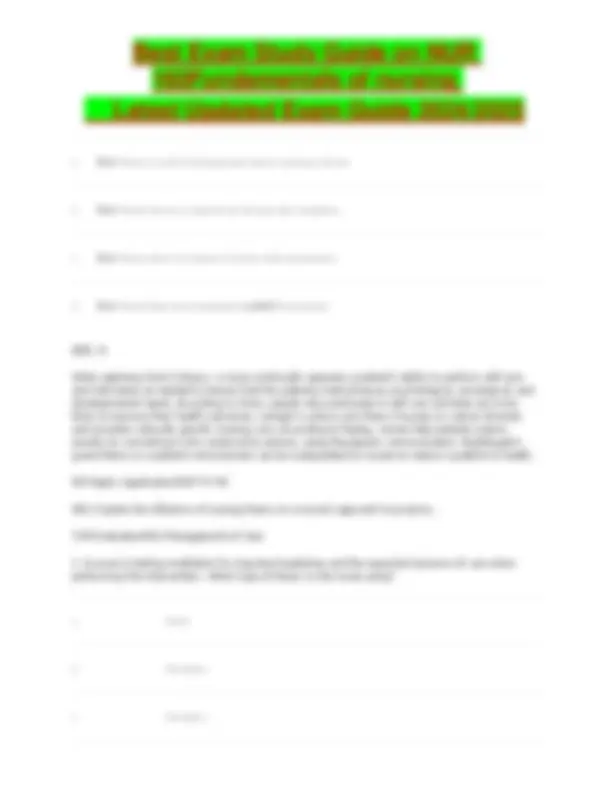

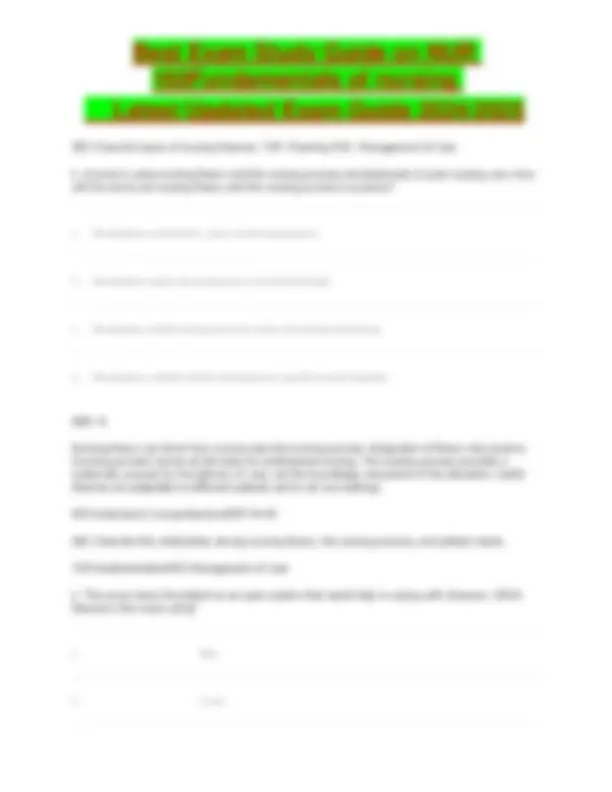

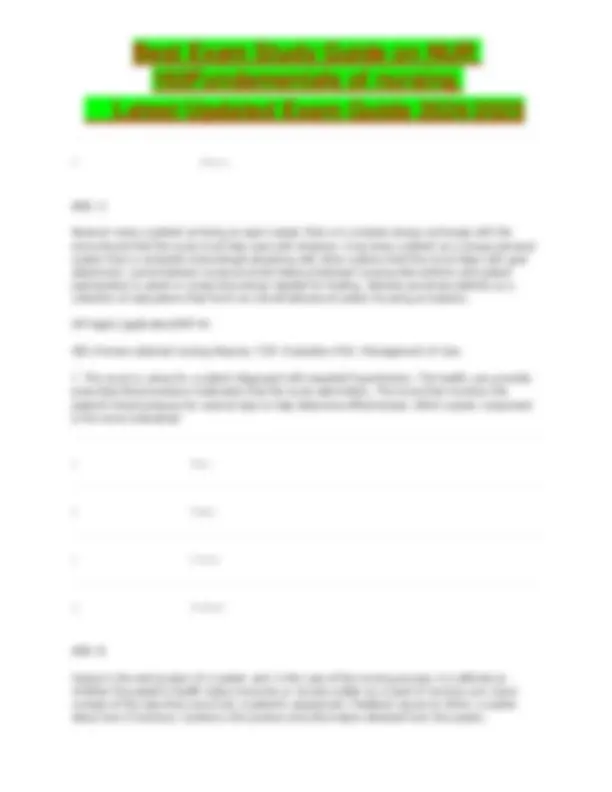

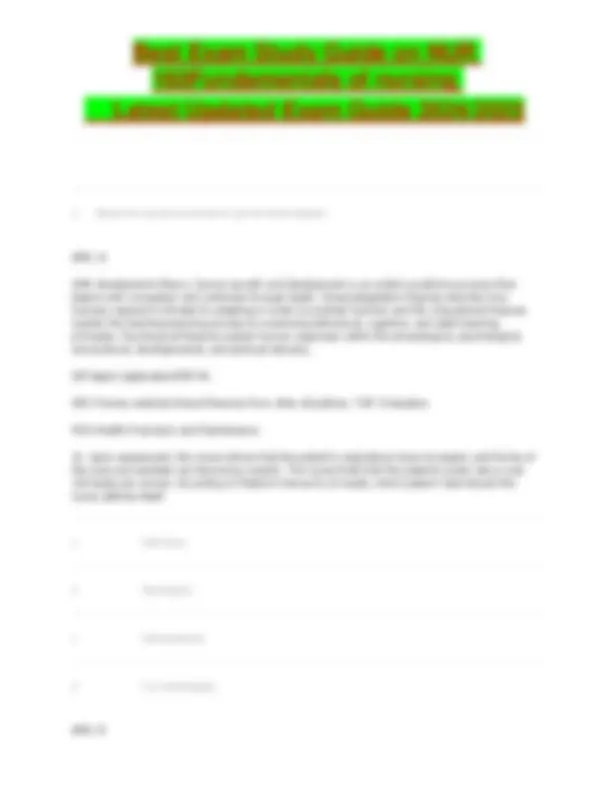
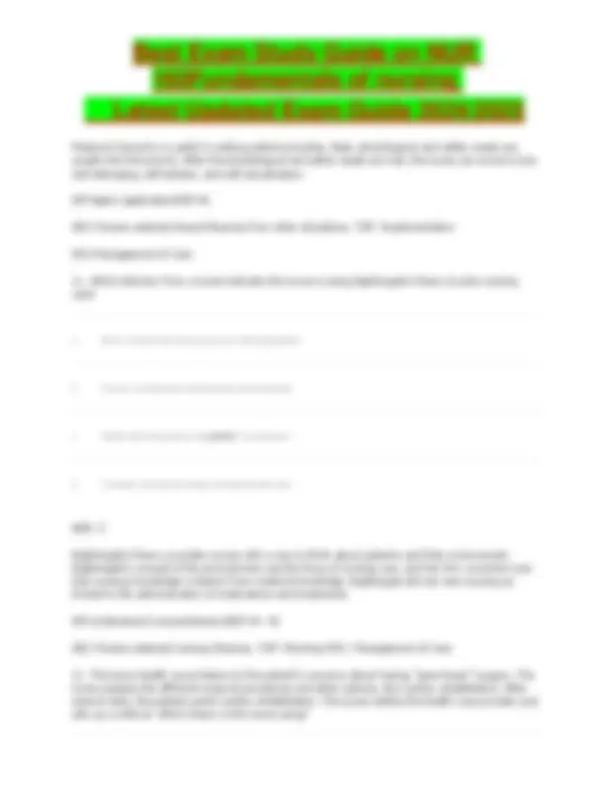

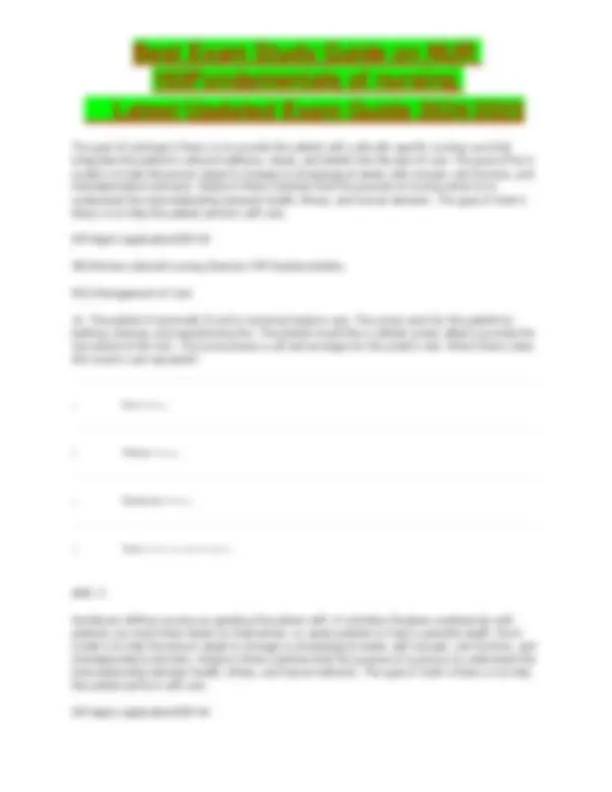

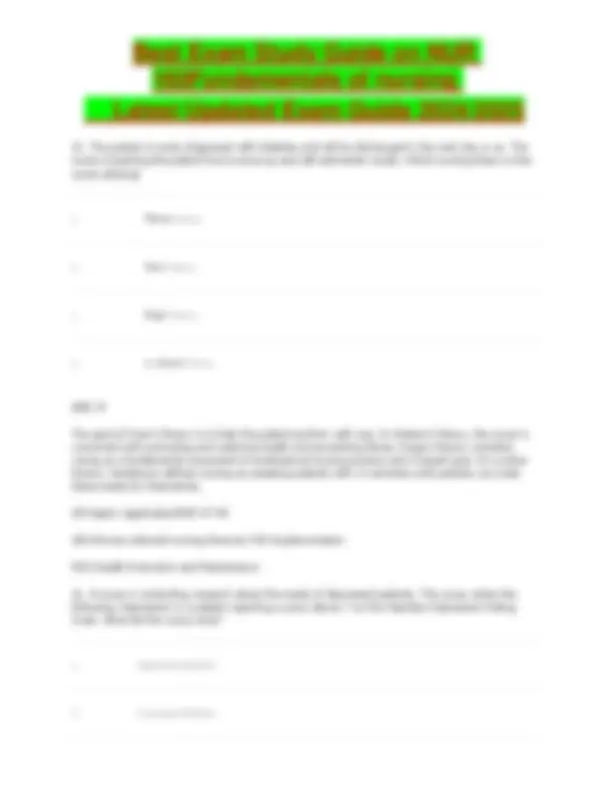

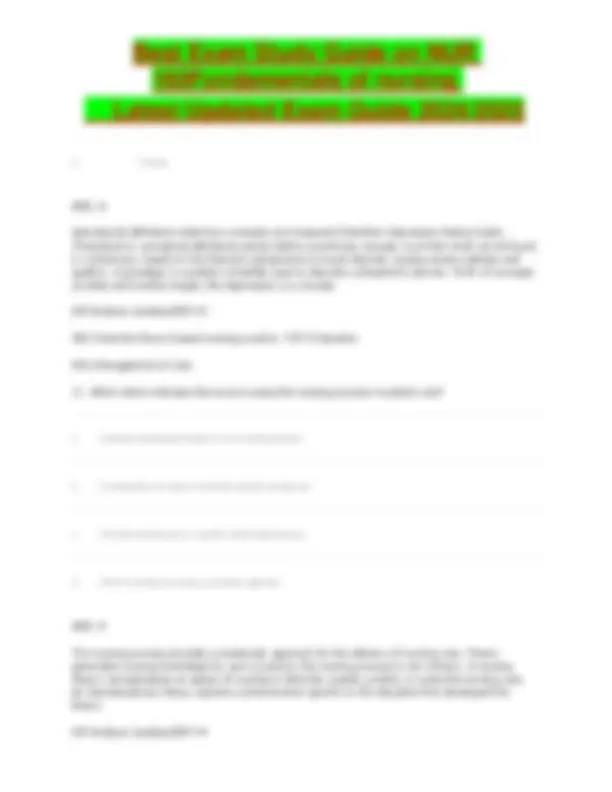

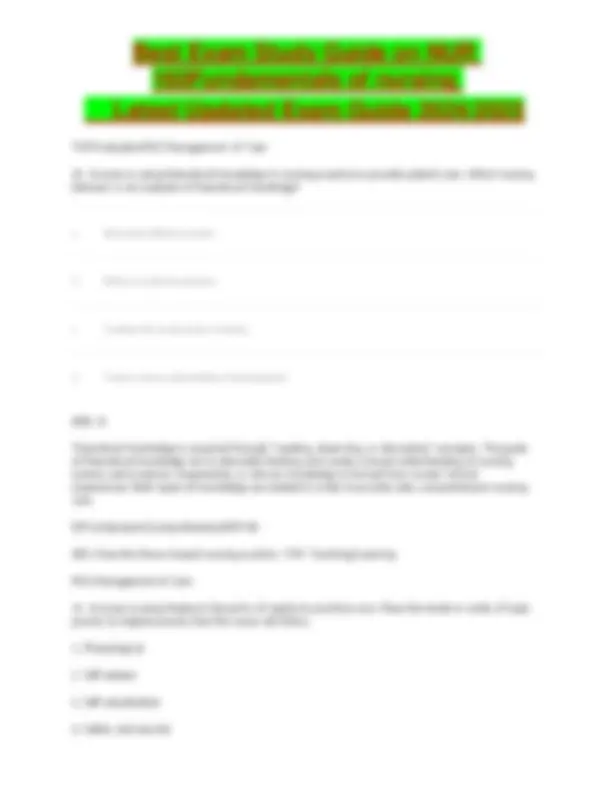

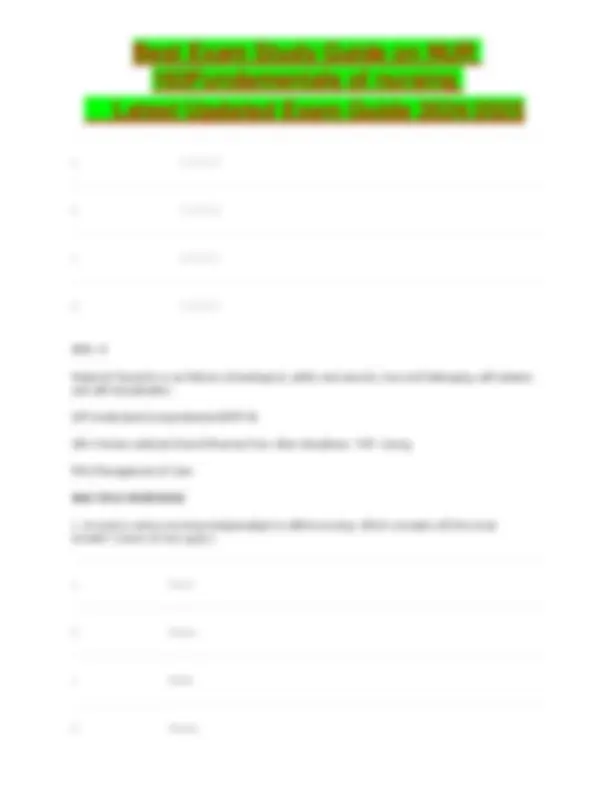
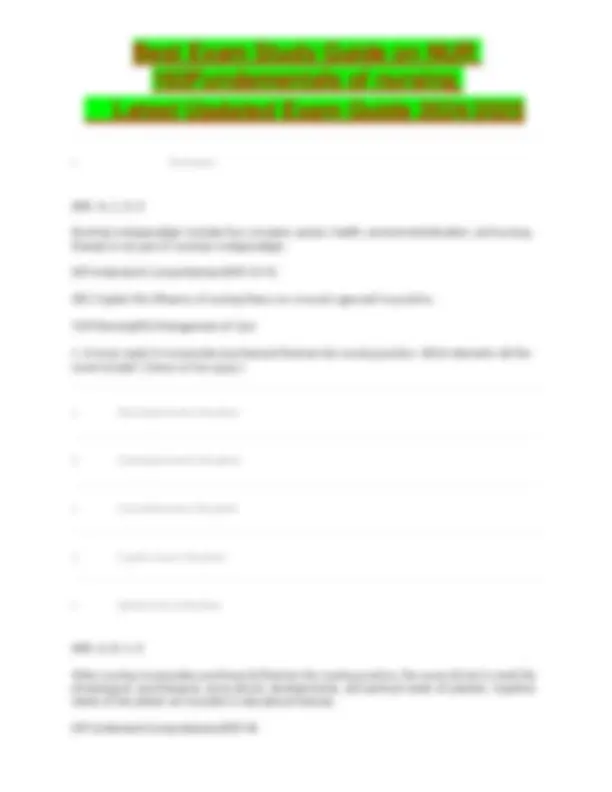

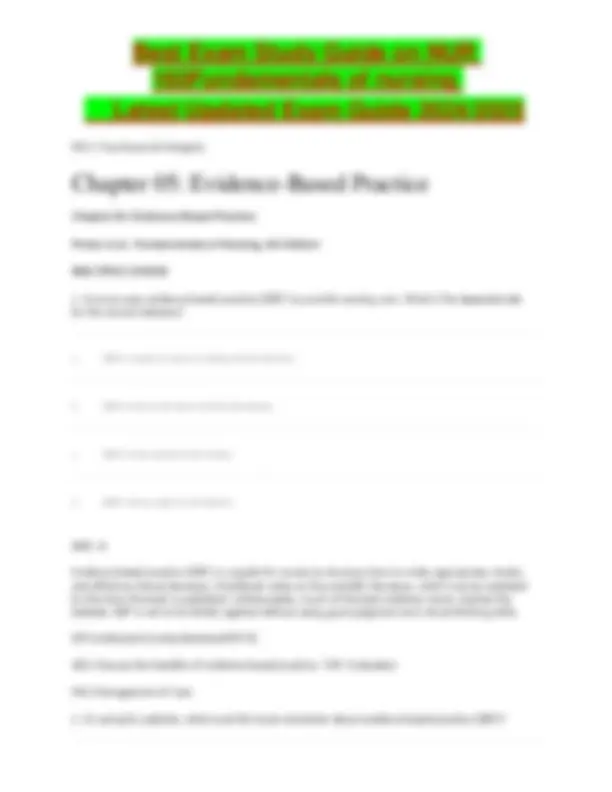

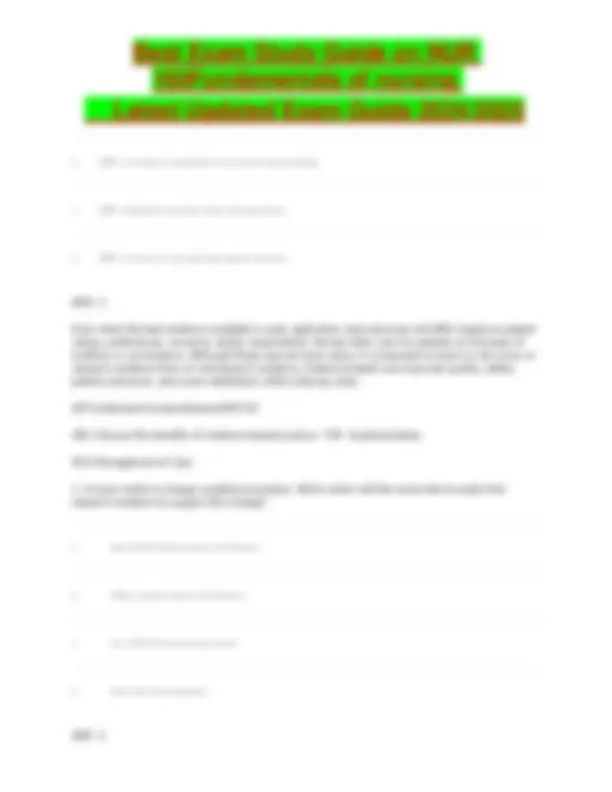

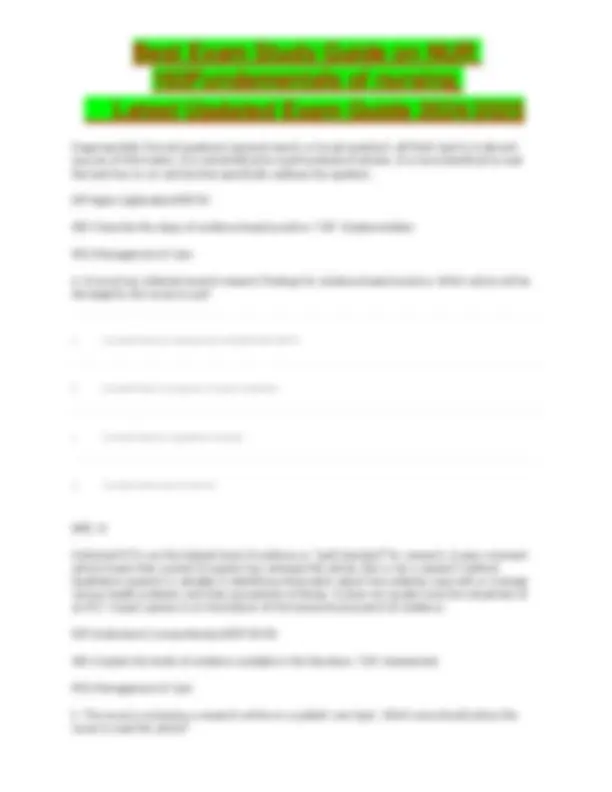

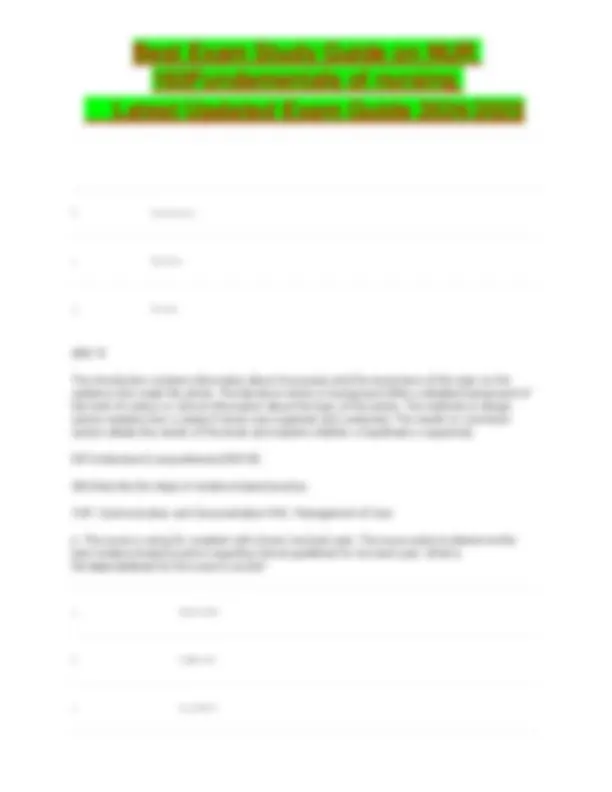

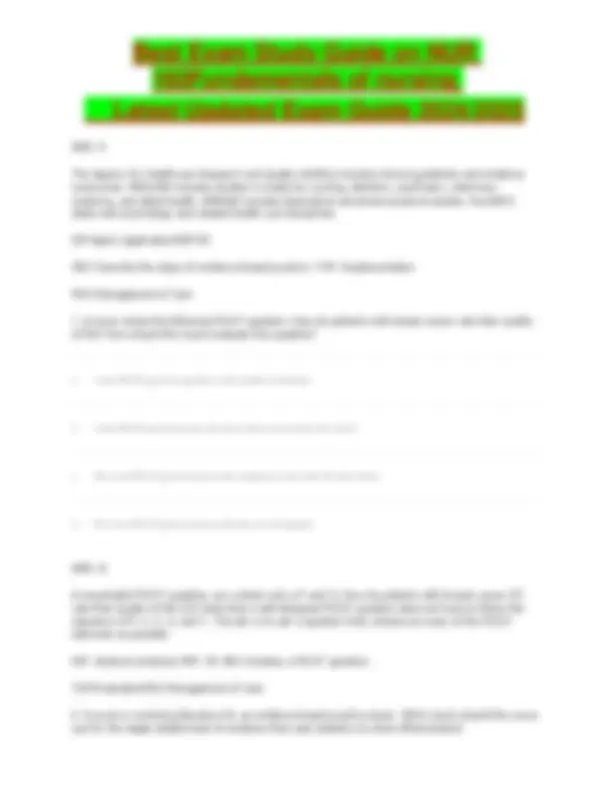

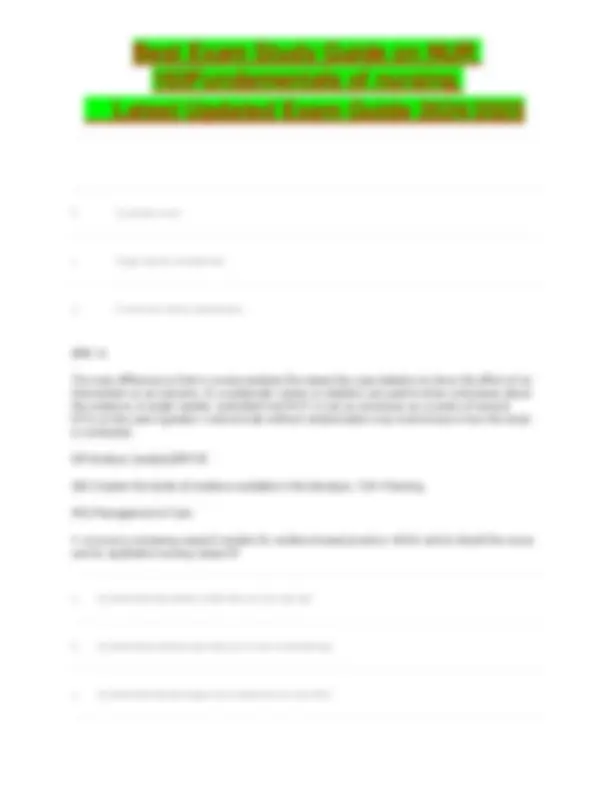

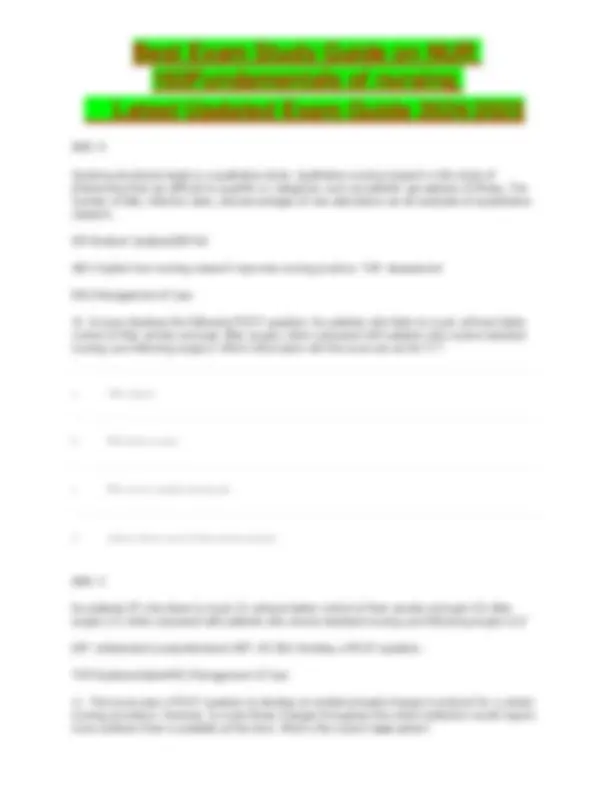

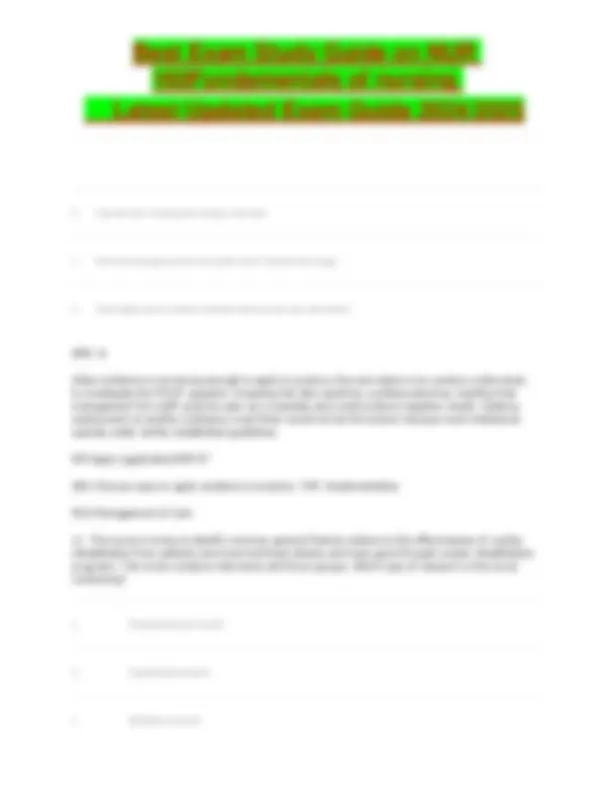

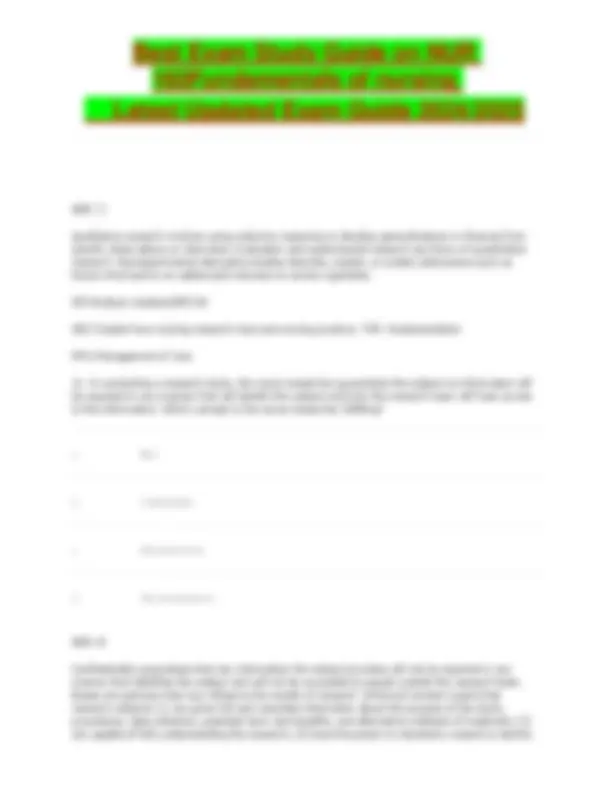

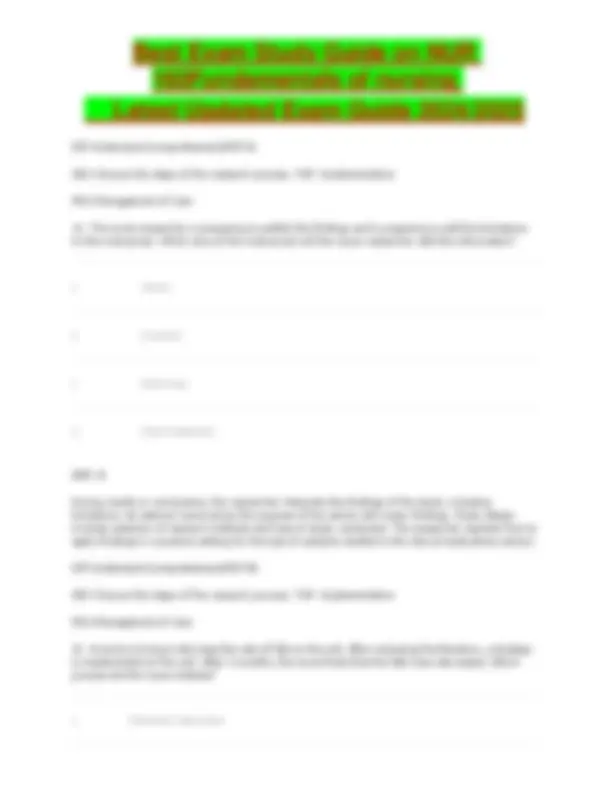

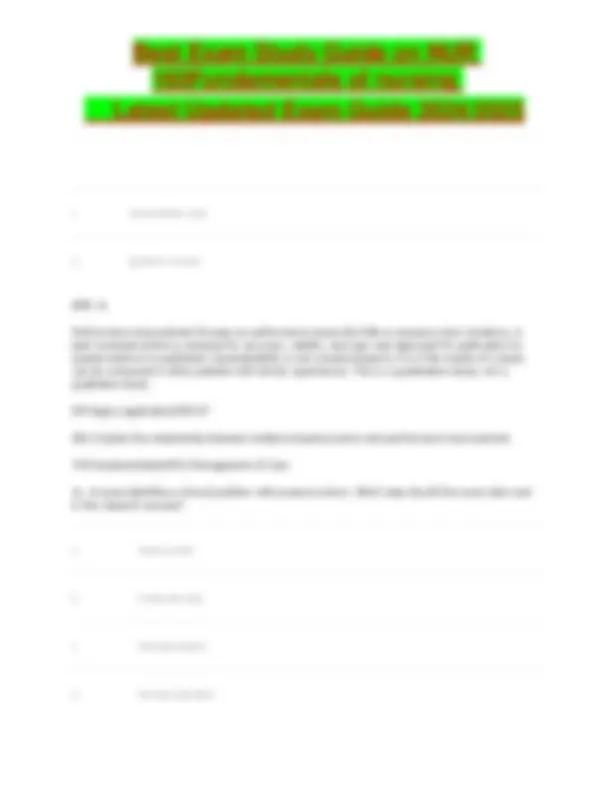

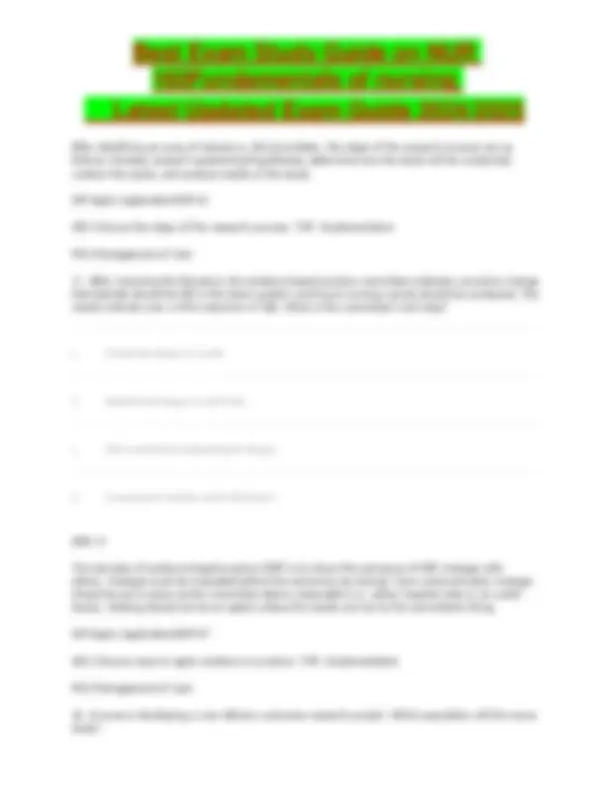

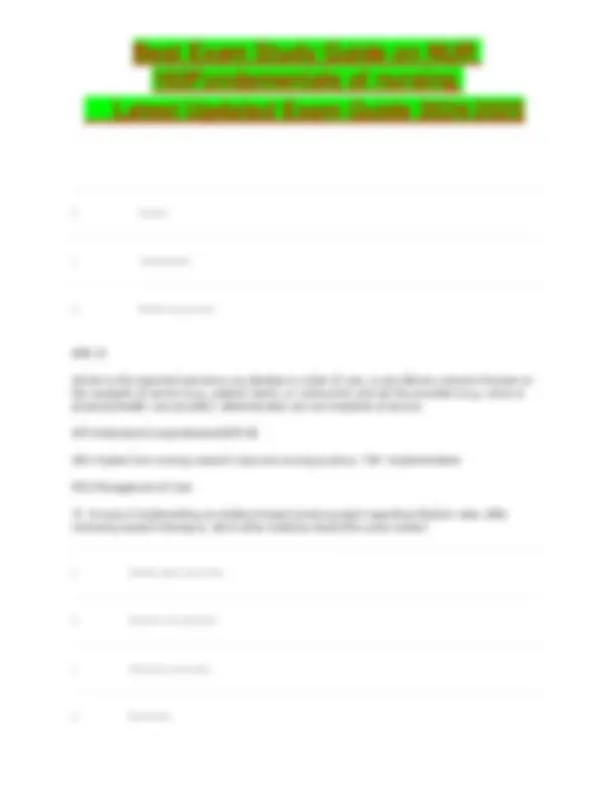

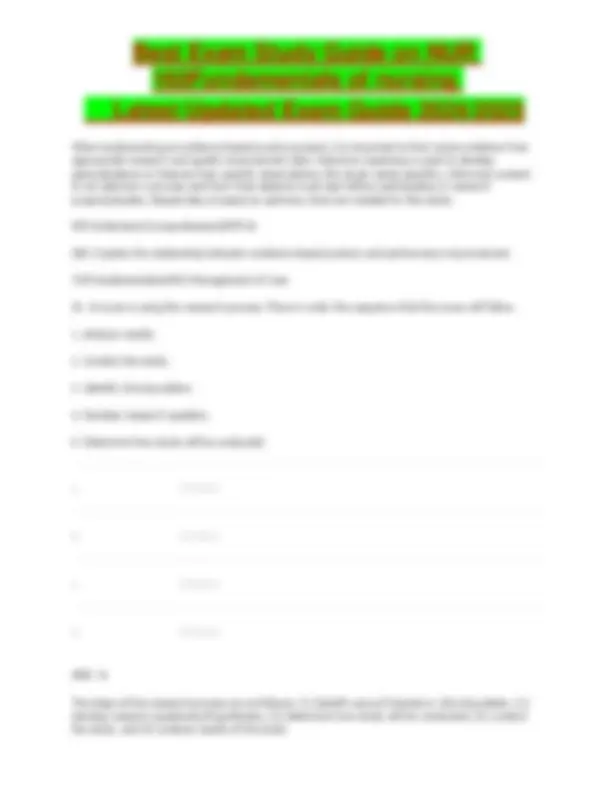

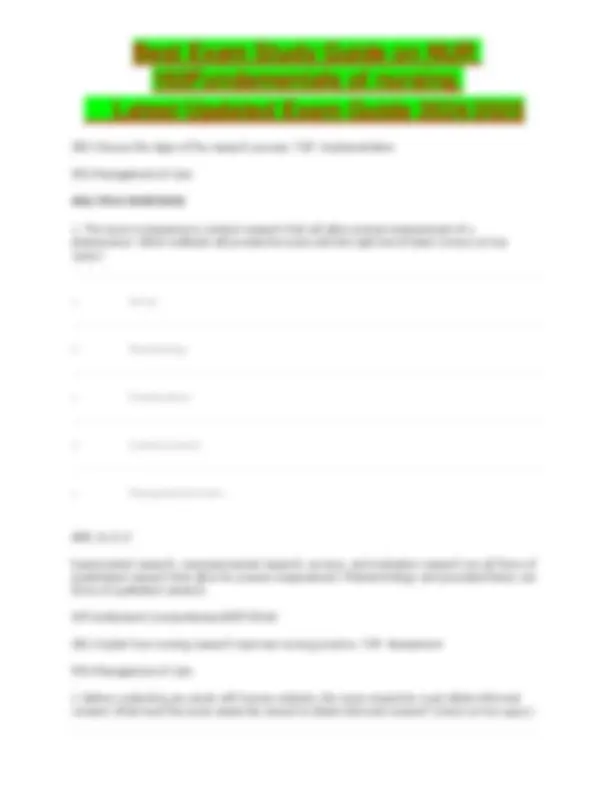

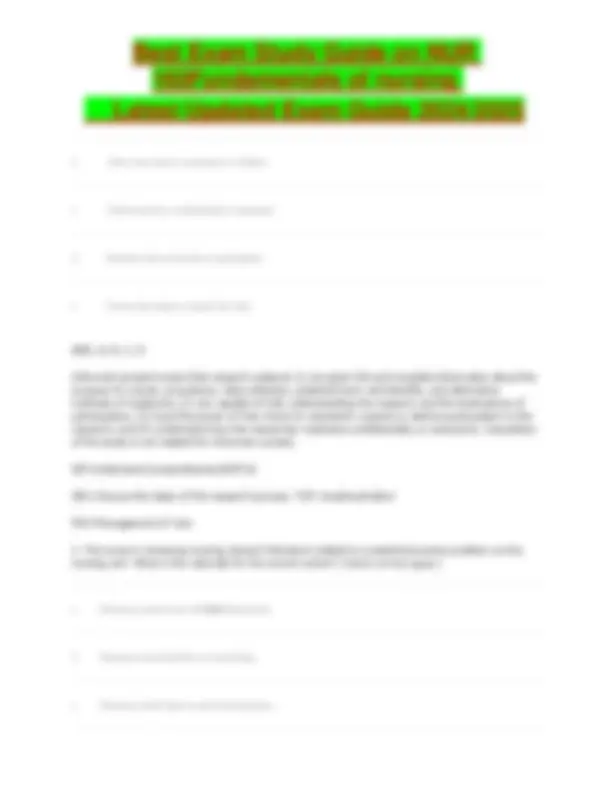

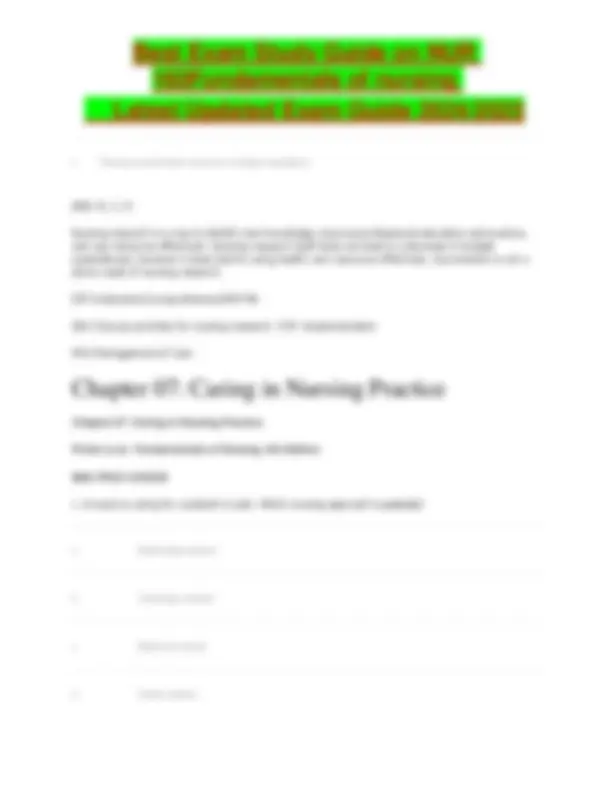

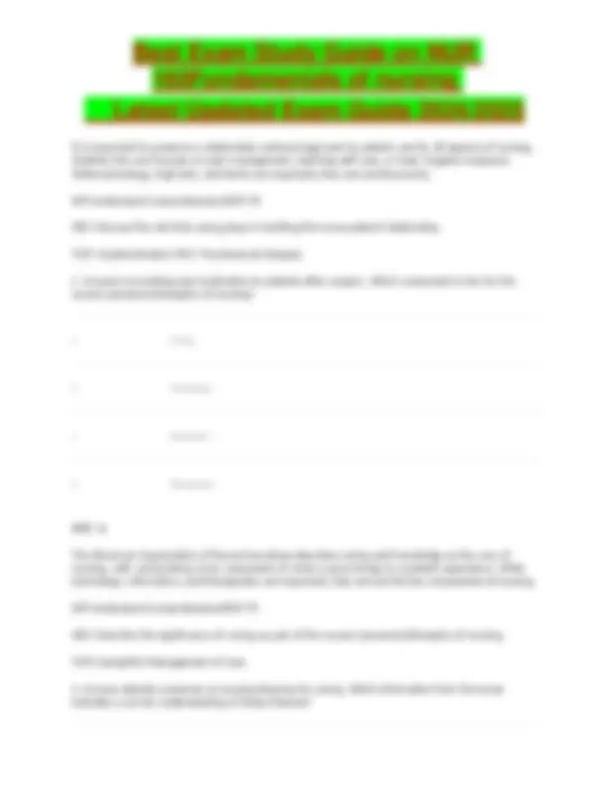

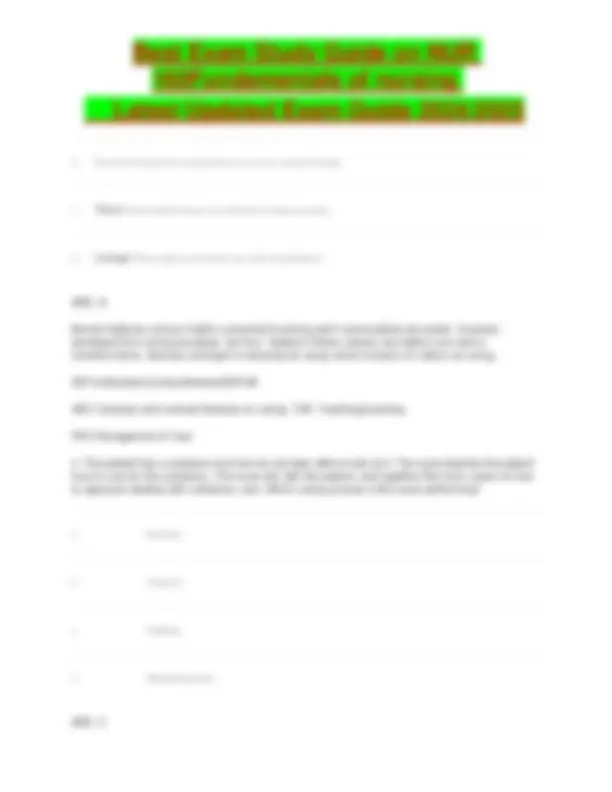

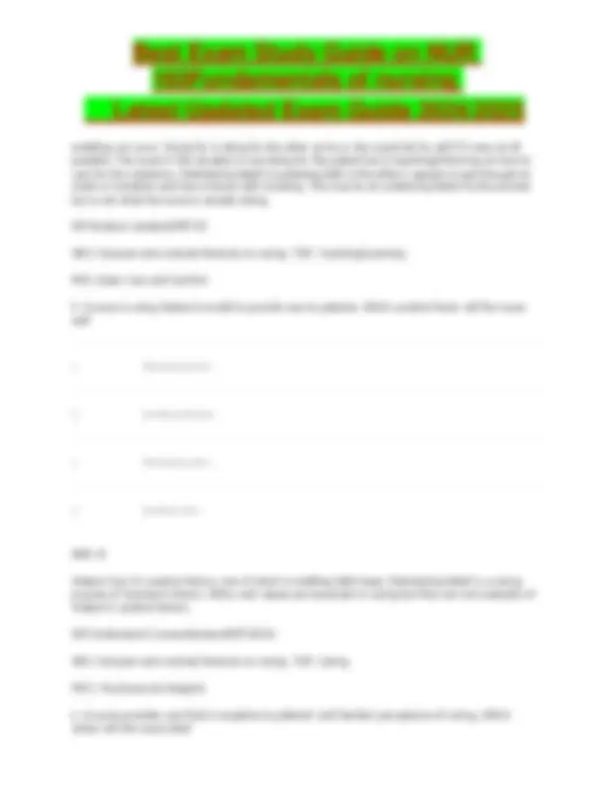

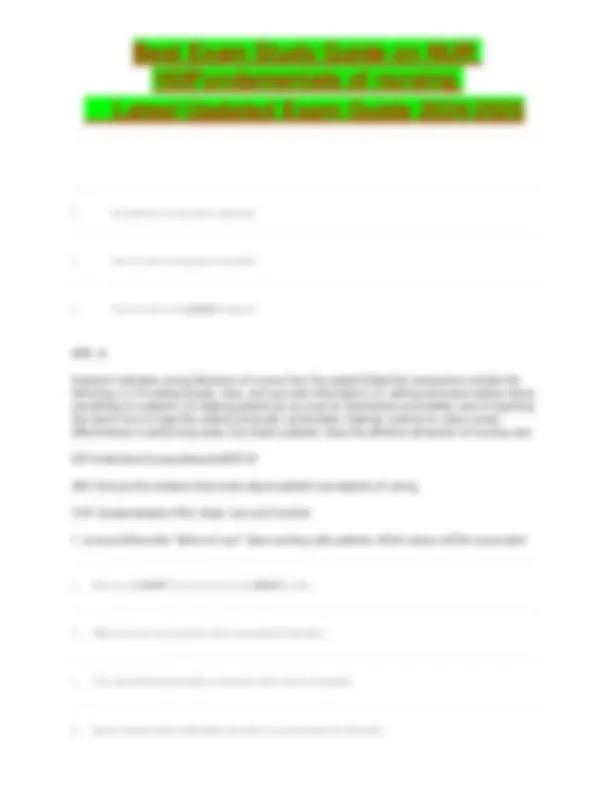

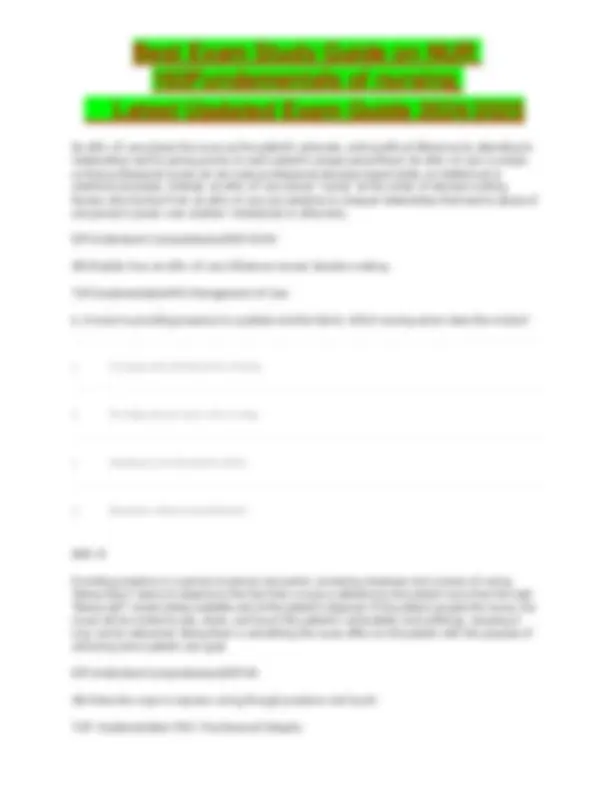

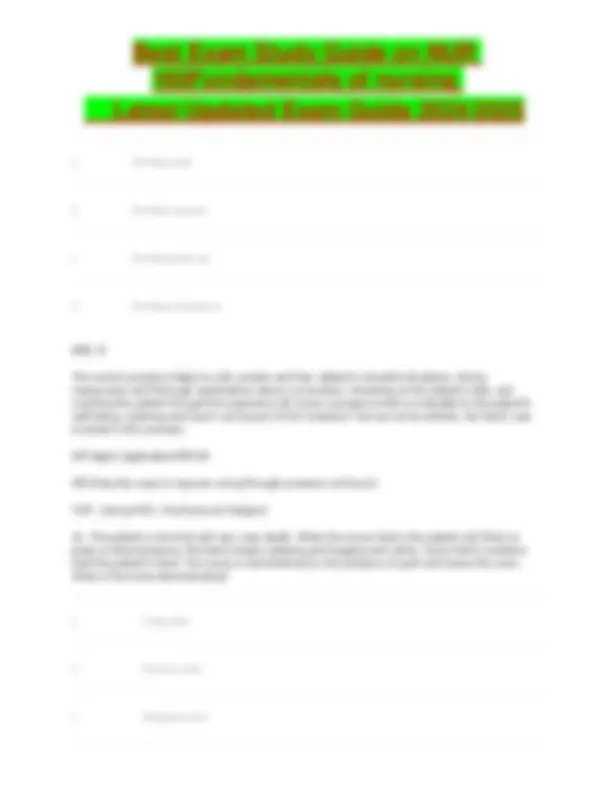

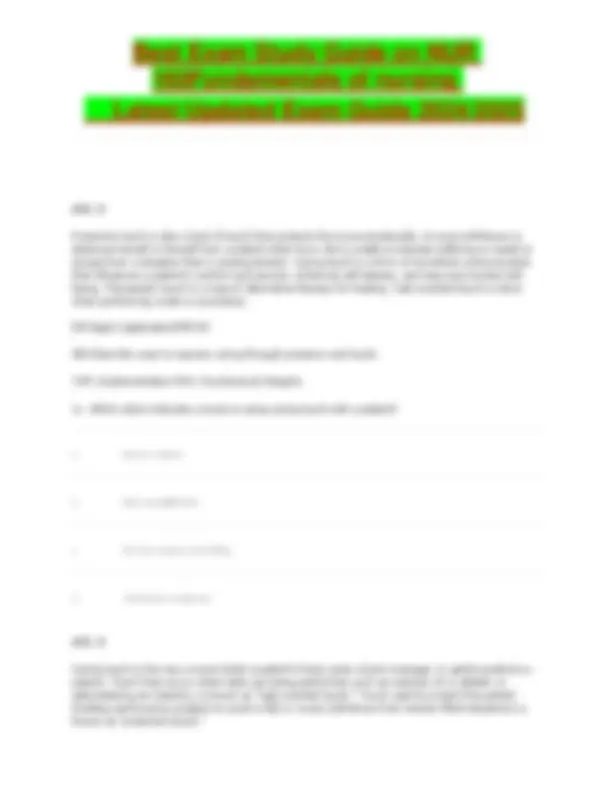

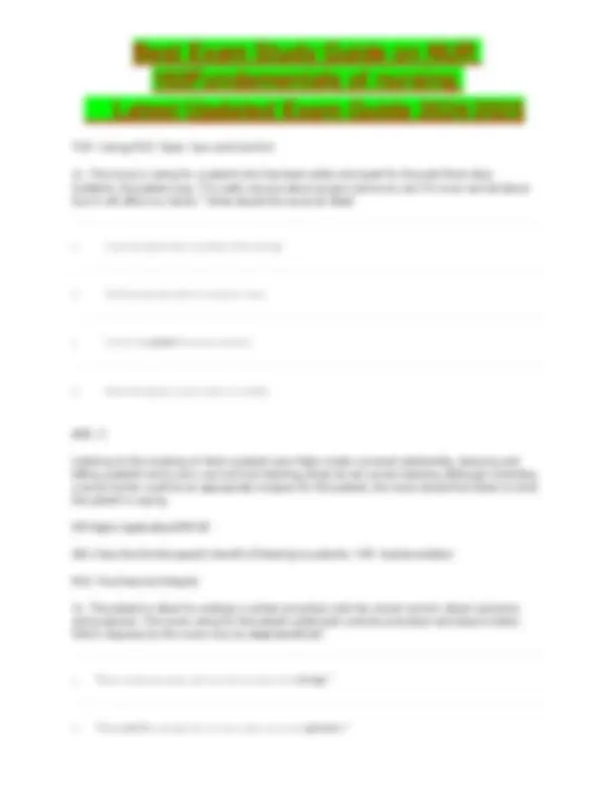
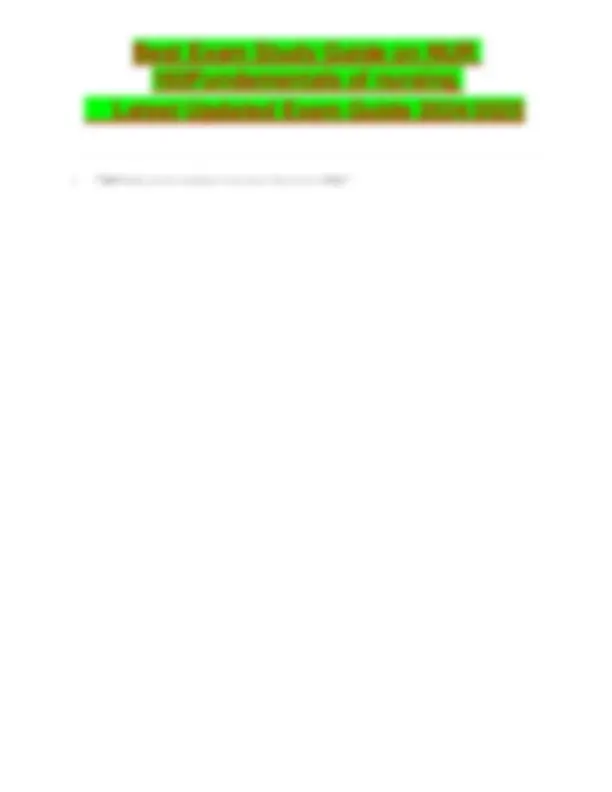
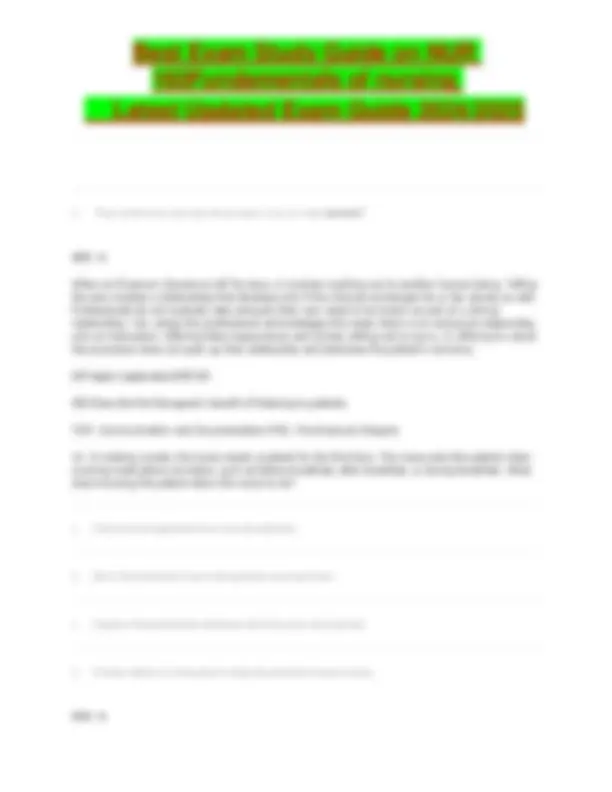

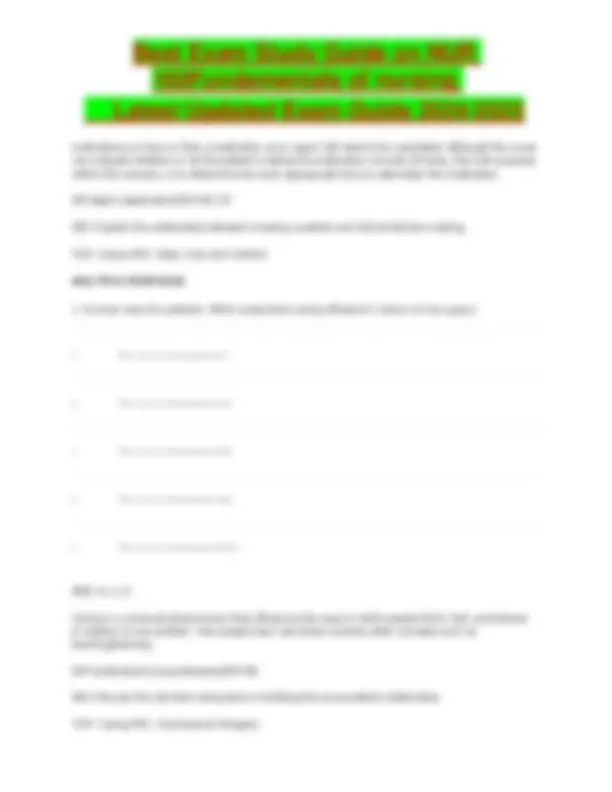

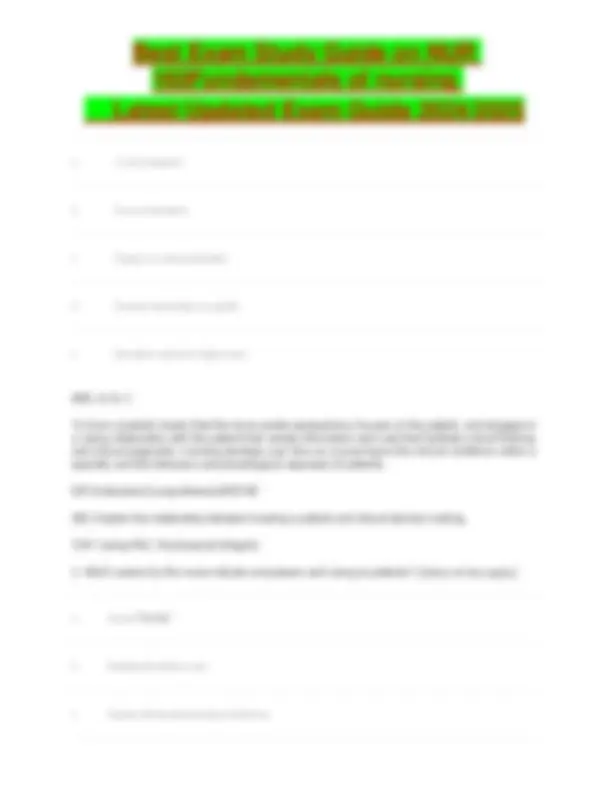

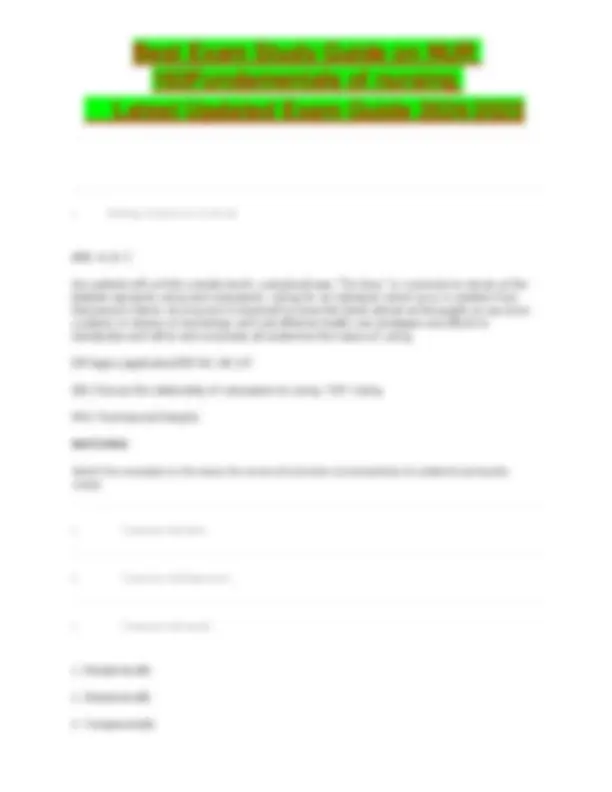
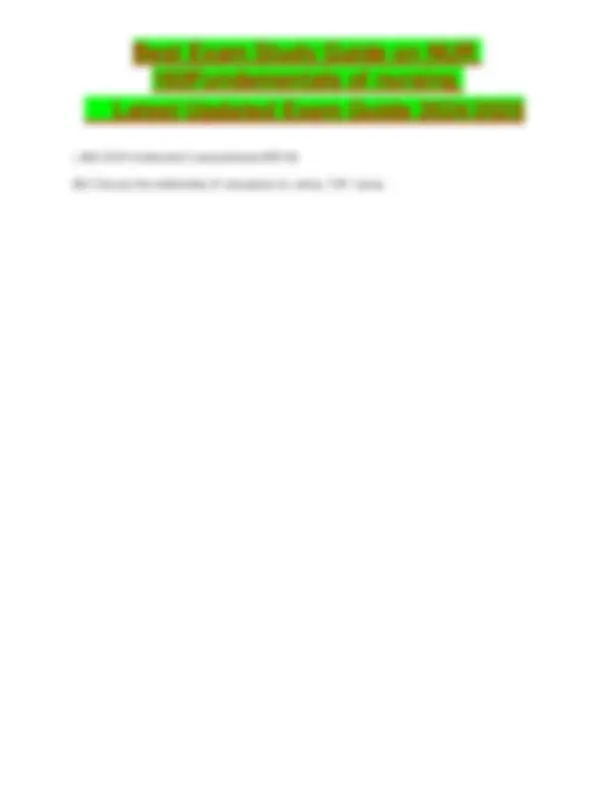
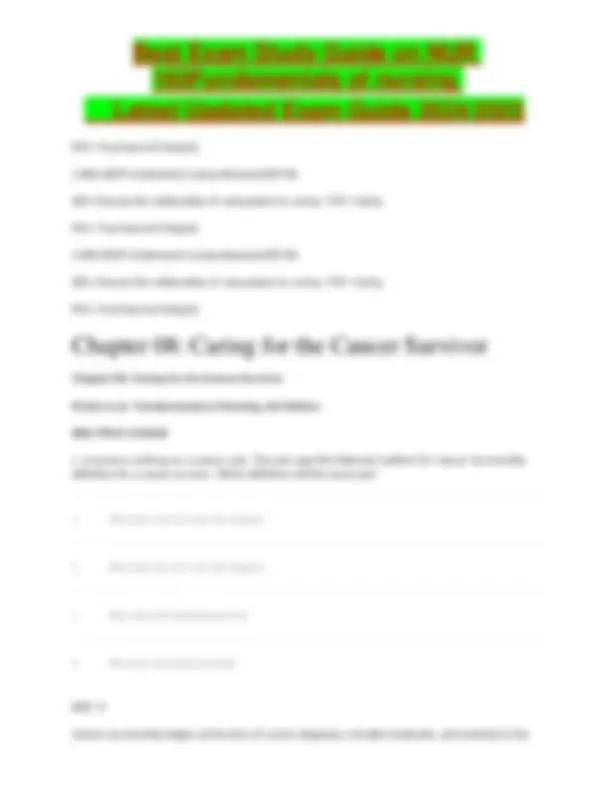

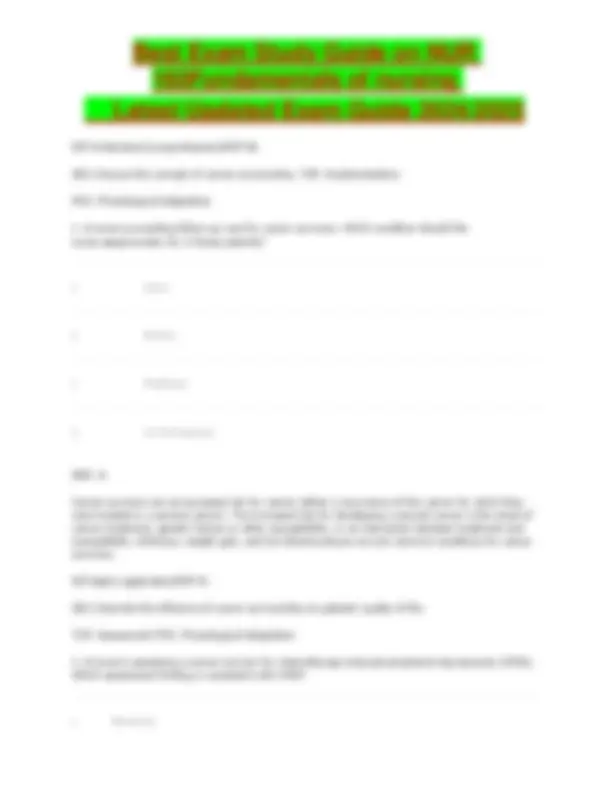

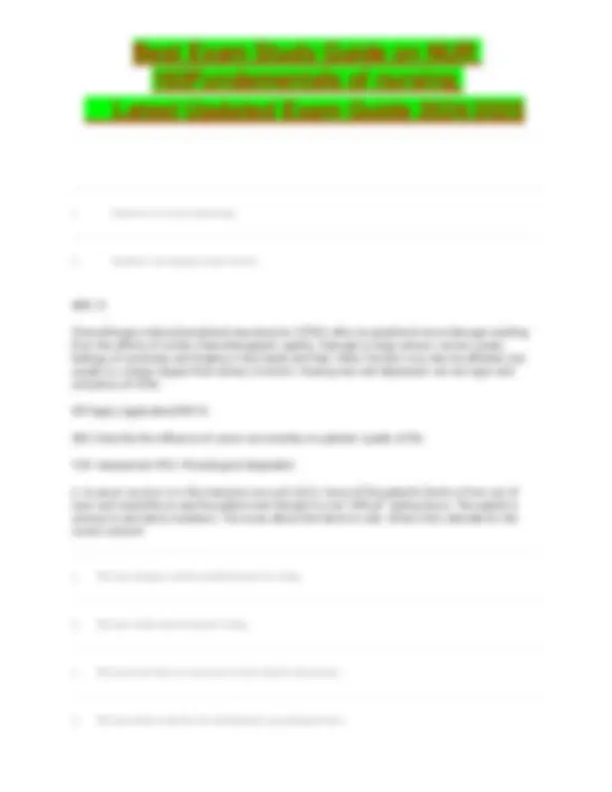

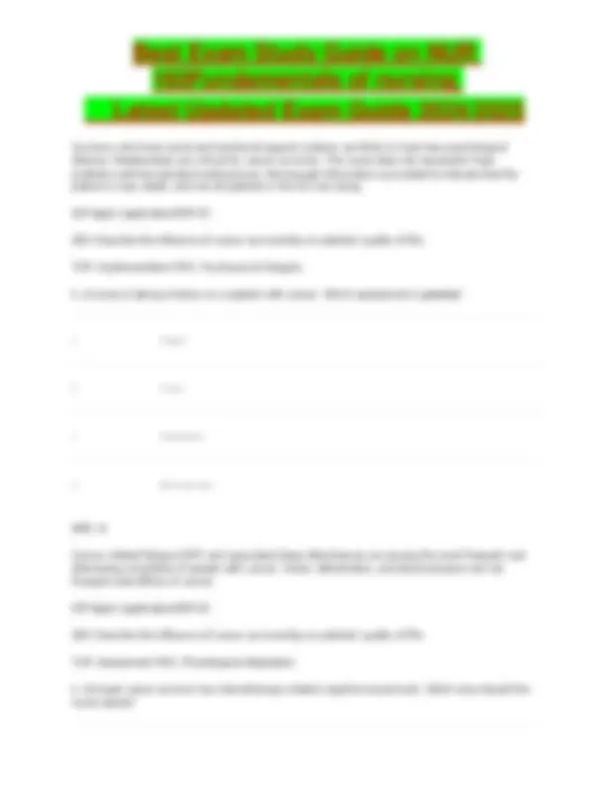

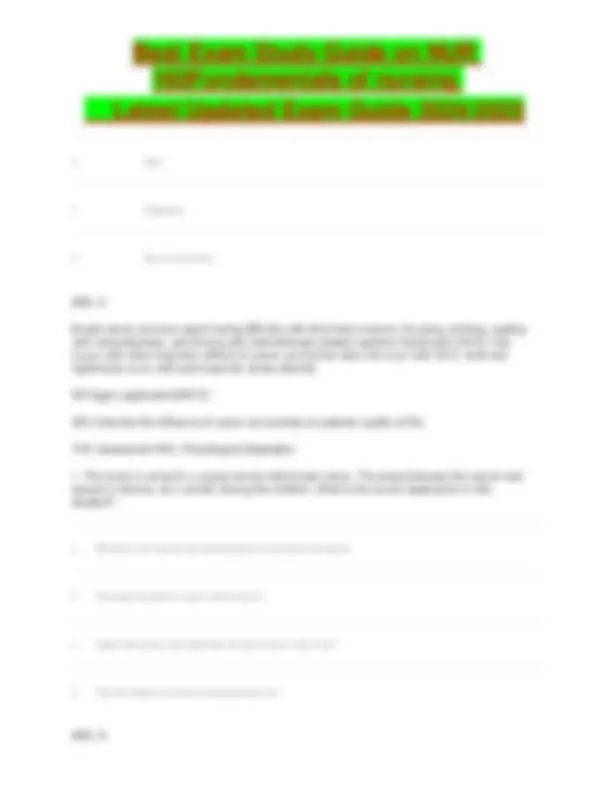

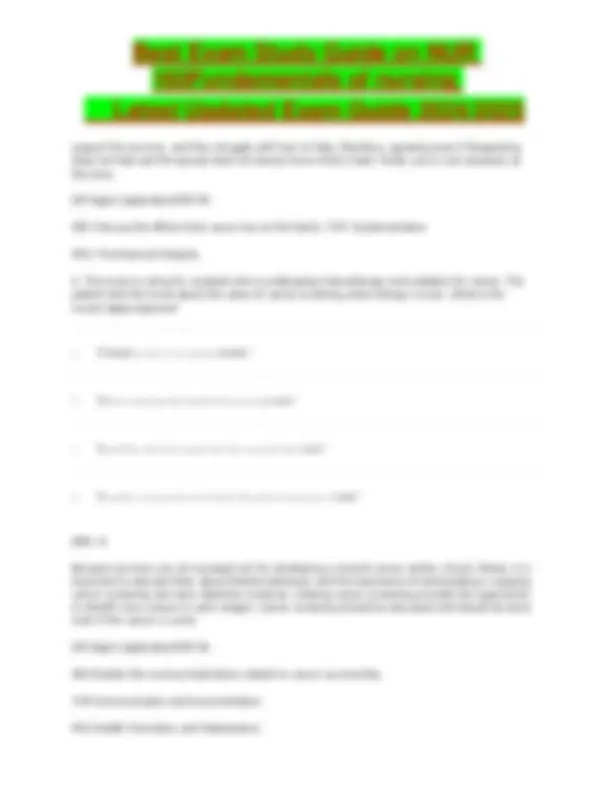

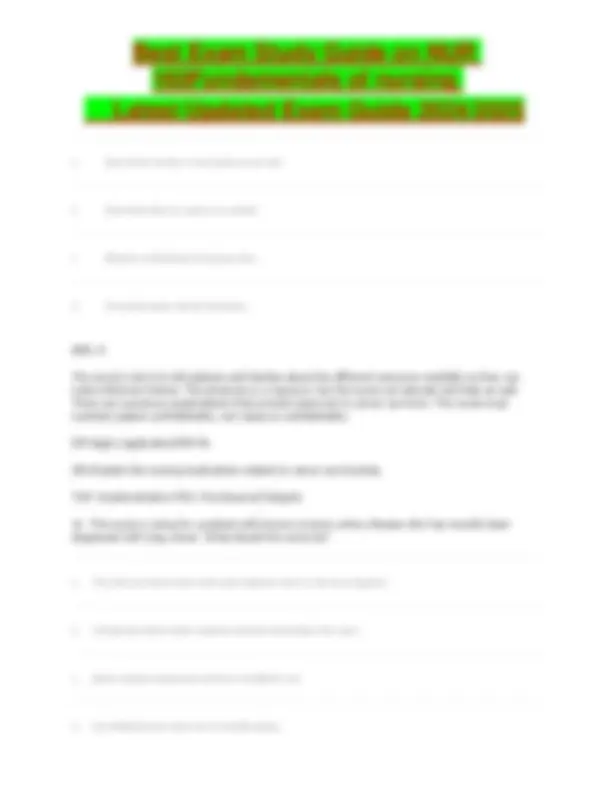


Study with the several resources on Docsity

Earn points by helping other students or get them with a premium plan


Prepare for your exams
Study with the several resources on Docsity

Earn points to download
Earn points by helping other students or get them with a premium plan
Community
Ask the community for help and clear up your study doubts
Discover the best universities in your country according to Docsity users
Free resources
Download our free guides on studying techniques, anxiety management strategies, and thesis advice from Docsity tutors
The Cell Cycle: Chapter 11 Study Guide Best Full Certified Exam Guide Latest Updated 2024/2025
Typology: Exams
1 / 1371

This page cannot be seen from the preview
Don't miss anything!





























































































Fundamentals of nursing study questions NUR 160
Chapter 04: Theoretical Foundations of Nursing Practice
Potter et al.: Fundamentals of Nursing, 9th Edition
a. “You are correct, but we have to learn it anyway.”
b. “This keeps the focus of nursing narrow.”
c. “Theories help explain why nurses do what they do.”
d. “Exposure to theories will help you later in graduate school.”
Theories offer well-grounded rationales for how and why nurses perform specific interventions and for predicting and/or prescribing nursing care measures. Although nursing theory will help the nurse in graduate school, it is also an important basis for the nurse’s approach to daily patient care, and it expands scientific knowledge of the profession.
DIF:Apply (application)REF:
OBJ: Explain the influence of nursing theory on a nurse’s approach to practice.
TOP:ImplementationMSC:Management of Care
a. Orem’s theory is useful in designing interventions to promote self-care.
b. Orem’s theory focuses on cultural issues that may affect compliance.
c. Orem’s theory allows for reduction of anxiety with communication.
d. Orem’s theory helps nurses manipulate the patient’s environment.
When applying Orem’s theory, a nurse continually assesses a patient’s ability to perform selfcare and intervenes as needed to ensure that the patients meet physical, psychological, sociological, and developmental needs. According to Orem, people who participate in self-care activities are more likely to improve their health outcomes. Leiniger’s culture care theory focuses on culture diversity and provides culturally specific nursing care. According to Peplau, nurses help patients reduce anxiety by converting it into constructive actions, using therapeutic communication. Nightingale’s grand theory is a patient’s environment can be manipulated by nurses to restore a patient to health.
DIF:Apply (application)REF:47-
OBJ: Explain the influence of nursing theory on a nurse’s approach to practice.
TOP:EvaluationMSC:Management of Care
a. Grand
b. Prescriptive
c. Descriptive
d. Middle-range
DIF:Apply (application)REF:
OBJ: Describe types of nursing theories. TOP: Planning MSC: Management of Care
a. Nursing theory can direct how a nurse uses the nursing process.
b. Nursing theory requires the nursing process to develop knowledge.
c. Nursing theory with the nursing process has a minor role in professional nursing.
d. Nursing theory combined with the nursing process is specific to certain ill patients.
Nursing theory can direct how a nurse uses the nursing process. Integration of theory into practice (nursing process) serves as the basis for professional nursing. The nursing process provides a systematic process for the delivery of care, not the knowledge component of the discipline. Useful theories are adaptable to different patients and to all care settings.
DIF:Understand (comprehension)REF:44-
OBJ: Describe the relationship among nursing theory, the nursing process, and patient needs.
TOP:ImplementationMSC:Management of Care
a. King
b. Levine
d. Johnson
Neuman views a patient as being an open system that is in constant energy exchange with the environment that the nurse must help cope with stressors. King views a patient as a unique personal system that is constantly interacting/transacting with other systems that the nurse helps with goal attainment. Levine believes nurses promote balance between nursing interventions and patient participation to assist in conserving energy needed for healing. Johnson perceives patients as a collection of subsystems that forms an overall behavioral system focusing on balance.
DIF:Apply (application)REF:
OBJ: Review selected nursing theories. TOP: Evaluation MSC: Management of Care
a. Input
b. Output
c. Content
d. Feedback
Output is the end product of a system and, in the case of the nursing process, it is defined as whether the patient’s health status improves or remains stable as a result of nursing care. Input consists of the data that come from a patient’s assessment. Feedback serves to inform a system about how it functions. Content is the product and information obtained from the system.
DIF:Apply (application)REF:
OBJ: Review selected shared theories from other disciplines. TOP: Evaluation
c. Humans respond with cognitive principles for growth and development.
d. Humans have psychosocial domains to growth and development.
With development theory, human growth and development is an orderly predictive process that begins with conception and continues through death. Stress/adaptation theories describe how humans respond to threats by adapting in order to maintain function and life. Educational theories explain the teaching-learning process by examining behavioral, cognitive, and adult-learning principles. Psychosocial theories explain human responses within the physiological, psychological, sociocultural, developmental, and spiritual domains.
DIF:Apply (application)REF:
OBJ: Review selected shared theories from other disciplines. TOP: Evaluation
MSC:Health Promotion and Maintenance
a. Self-esteem
b. Physiological
c. Self-actualization
d. Love and belonging
a. Peplau’s theory
b. Henderson’s theory
c. Nightingale’s theory
d. Orem’s self-care deficit theory
Peplau’s theory focuses on the individual, the nurse, and the interactive process or nurse-patient relationship. The nurse serves as a resource person, counselor, and surrogate. Henderson’s theory focuses on helping the patient with activities that the patient would perform unaided if he or she were able. Nightingale viewed nursing not as limited to the administration of medications and treatments but rather as oriented toward providing fresh air, light, warmth, cleanliness, quiet, and adequate nutrition. The goal of Orem’s theory is to help the patient perform selfcare.
DIF:Apply (application)REF:
OBJ:Review selected nursing theories.TOP:Implementation
MSC: Psychosocial Integrity
a. Roy’s theory
b. Leininger’s theory
c. Watson’s theory
d. Orem’s theory
The goal of Leininger’s theory is to provide the patient with culturally specific nursing care that integrates the patient’s cultural traditions, values, and beliefs into the plan of care. The goal of Roy’s model is to help the person adapt to changes in physiological needs, self-concept, role function, and interdependence domains. Watson’s theory believes that the purpose of nursing action is to understand the interrelationship between health, illness, and human behavior. The goal of Orem’s theory is to help the patient perform self-care.
DIF:Apply (application)REF:
OBJ:Review selected nursing theories.TOP:Implementation
MSC:Management of Care
a. Roy’s theory
b. Watson’s theory
c. Henderson’s theory
d. Orem’s self-care deficit theory
Henderson defines nursing as assisting the patient with 14 activities (hygiene, positioning) until patients can meet these needs for themselves—or assist patients to have a peaceful death. Roy’s model is to help the person adapt to changes in physiological needs, self-concept, role function, and interdependence domains. Watson’s theory believes that the purpose of nursing is to understand the interrelationship between health, illness, and human behavior. The goal of Orem’s theory is to help the patient perform self-care.
DIF:Apply (application)REF:
OBJ: Review selected nursing theories. TOP: Evaluation MSC: Management of Care